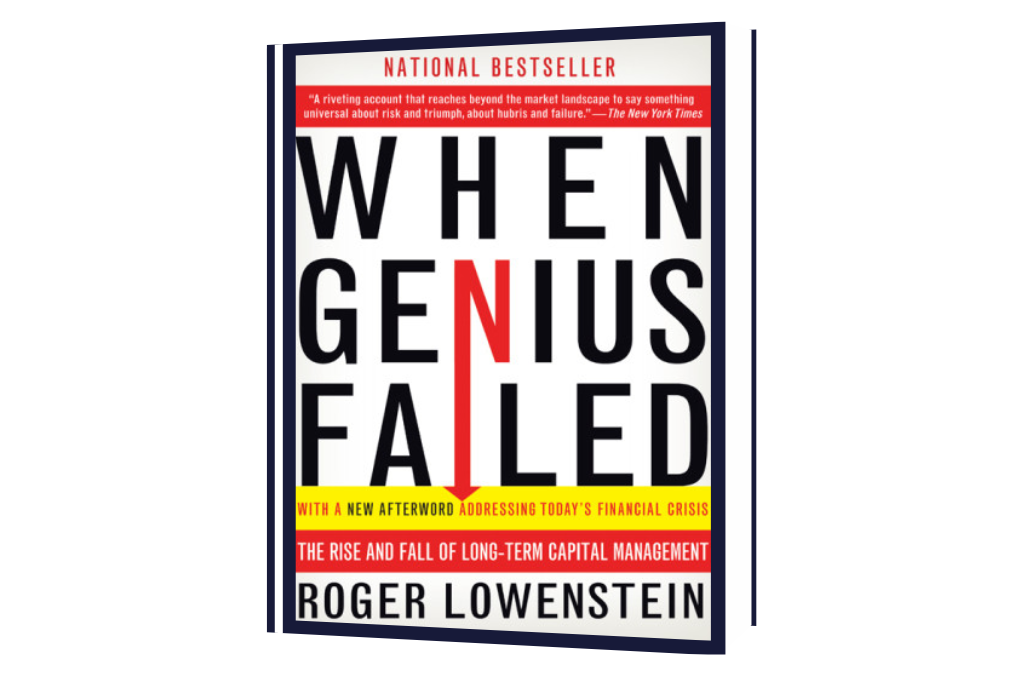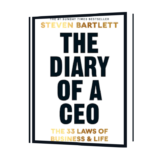Then, in 1991, in the wake of a scandal involving one of his traders, Meriwether abruptly resigned. For two years, his fiercely loyal team–convinced that the chief had been unfairly victimized–plotted their boss’s return. Then, in 1993, Meriwether made a historic offer. He gathered together his former disciples and a handful of supereconomists from academia and proposed that they become partners in a new hedge fund different from any Wall Street had ever seen. And so Long-Term Capital Management was born.
“When Genius Failed: The Rise and Fall of Long-Term Capital Management” is a detailed account of the dramatic collapse of Long-Term Capital Management (LTCM), a hedge fund that was once considered the epitome of financial genius. Written by Roger Lowenstein, the book chronicles the rise, fall, and eventual implosion of LTCM, which became a symbol of the risks and fragility inherent in the financial world, especially when hubris and excessive leverage are involved.
Background and Founding of LTCM
Long-Term Capital Management was founded in 1994 by a group of highly accomplished individuals, including two Nobel Prize-winning economists—Myron Scholes and Robert Merton—along with renowned bond trader John Meriwether. The fund was built on the premise that sophisticated financial models could be used to predict market movements and achieve high, consistent returns by exploiting small mispricings in the market. The strategy primarily involved arbitrage, betting on the price differences between related financial instruments, such as government bonds and futures.
The founders of LTCM were celebrated as geniuses, and the fund was designed to leverage their intellectual expertise and advanced mathematical models to produce steady profits. LTCM’s approach combined statistical analysis, large-scale leveraging, and complex financial instruments like derivatives to execute its strategies.
LTCM’s Rapid Growth
Initially, LTCM was highly successful. Within its first few years, the fund posted outstanding returns, often in the 40%-50% range annually. The returns were so impressive that the hedge fund attracted substantial investments from wealthy individuals, banks, and institutional investors. The fund’s financial models and strategies seemed to offer a near-riskless way to earn massive returns, and the fund gained a reputation for being virtually infallible.
LTCM’s core strategy relied on the assumption that financial markets were efficient and that any deviations from theoretical pricing would correct themselves over time. The managers believed that small, temporary mispricings could be exploited through large positions, using leverage (borrowing) to magnify the returns.
The Role of Leverage
A critical factor in LTCM’s growth was its use of leverage. The firm borrowed vast amounts of money, often at 20-to-1 or even 30-to-1 ratios. This meant that for every dollar of capital LTCM had, it was borrowing 20 to 30 dollars. This extreme leverage magnified both potential returns and risks. At its peak, LTCM had amassed more than $100 billion in positions, even though it started with just a few billion in capital.
The Fall of LTCM
Despite its initial success, LTCM’s reliance on mathematical models and extreme leverage left the fund vulnerable to unforeseen market events. In 1998, several factors combined to trigger the fund’s downfall:
The Russian Financial Crisis (1998): In August 1998, Russia defaulted on its debt, which triggered a global financial crisis. The event sent shockwaves through the global financial system, causing the value of Russian bonds to collapse and creating instability in other markets as well.
The LTCM Strategy’s Vulnerability: LTCM’s portfolio was heavily concentrated in bond arbitrage and other strategies that assumed relatively stable market conditions. The Russian default caused the markets to behave in ways that LTCM’s models did not predict. Asset prices did not move in the expected direction, and the correlations that LTCM had counted on began to break down.
The Collapse of Liquidity: As markets became more volatile, LTCM found itself unable to unwind its positions without incurring substantial losses. The fund’s leverage amplified these losses, and it became clear that LTCM was in trouble. The models that had once been so successful now seemed utterly inadequate to cope with the severe market dislocations that followed the crisis.
Margin Calls and Losses: Due to the fund’s massive borrowing, LTCM faced significant margin calls—demands for additional capital to cover its leveraged positions. The fund’s partners did not have enough liquid assets to meet these demands, and LTCM’s losses quickly mounted. At its peak, LTCM had lost more than $4 billion of its $4.7 billion in equity in a matter of weeks.
The Financial System at Risk
As LTCM’s troubles became apparent, it became clear that its failure had the potential to destabilize the broader financial system. LTCM was deeply interconnected with major global banks and financial institutions, many of which had invested heavily in the hedge fund or had direct exposure through derivatives contracts. The collapse of LTCM threatened to lead to a cascading effect, with potential defaults that could damage the entire financial system.
The sheer scale of LTCM’s positions, along with the interconnectedness of its counterparties, raised concerns that its failure could trigger a global financial panic. Many of the institutions involved were highly leveraged themselves, and if LTCM were forced to liquidate its positions in a chaotic manner, it could have led to widespread financial contagion.
The Bailout
In response to the growing crisis, a consortium of major Wall Street banks and financial institutions stepped in to bail out LTCM. The Federal Reserve, led by Chairman Alan Greenspan, was deeply involved in coordinating the rescue efforts. A consortium of major banks, including firms like J.P. Morgan, Bankers Trust, and others, agreed to provide a $3.65 billion rescue package to prevent LTCM from collapsing and causing further damage to the global financial system.
The bailout was controversial. Some argued that it was a necessary intervention to prevent a broader financial crisis, while others believed that it sent the wrong message: that reckless behavior by financial institutions would be rewarded by government or private sector intervention. Critics argued that LTCM’s failure should have been allowed to run its course to send a signal to the markets about the dangers of excessive risk-taking.
The Aftermath
LTCM’s downfall raised numerous questions about risk management, financial modeling, and the regulation of financial markets. The fund’s managers, despite their intellectual brilliance, had failed to account for extreme market conditions, demonstrating the limitations of relying purely on mathematical models and algorithms to predict market behavior.
LTCM’s collapse also prompted greater scrutiny of the financial industry, particularly hedge funds and other highly leveraged institutions. The event was one of the catalysts for discussions about financial market regulation and the potential need for more oversight of hedge funds and other systemic institutions.
“When Genius Failed” is a cautionary tale ab
out the dangers of hubris, excessive leverage, and overconfidence i
Roger Lowenstein’s When Genius Failed: The Rise and Fall of Long-Term Capital Management tells the riveting and cautionary tale of the dramatic rise and subsequent collapse of Long-Term Capital Management (LTCM), a hedge fund that, at its peak, was considered the epitome of financial genius. It chronicles the firm’s meteoric rise, the role played by the financial elites and Nobel laureates behind it, and the disastrous collapse that nearly triggered a global financial crisis in 1998.
Introduction: The Promise of Innovation
Long-Term Capital Management (LTCM) was founded in 1994 by John Meriwether, a former Salomon Brothers bond trader, and a group of financial experts, including two Nobel Prize-winning economists, Myron Scholes and Robert Merton, along with renowned financial theorist and MIT professor, David Mullins. These founders were at the height of their professions, and LTCM was based on cutting-edge financial theories, including modern portfolio theory and the Nobel-winning Black-Scholes options pricing model. The firm’s ambition was to revolutionize trading by applying complex mathematical models to predict market movements and arbitrage inefficiencies in global markets.
The allure of LTCM’s business model lay in its ability to minimize risk through the application of quantitative methods. Scholes and Merton had won the Nobel Prize for developing the Black-Scholes model, which allowed options to be priced based on mathematical formulas that took into account various risk factors. At LTCM, these models were adapted for trading in a range of instruments, including bonds, futures, and derivatives, by leveraging vast amounts of capital.
LTCM’s traders, including many of the world’s top minds in finance and economics, used these sophisticated models to find small price discrepancies in global financial markets. The firm made large bets based on the idea that market prices, particularly for fixed-income securities, would eventually converge to their “true” value. With a highly leveraged portfolio, even small price movements could generate substantial profits.
The fund’s promise was immense. At the outset, LTCM raised $1.25 billion in capital, and its assets quickly ballooned to more than $100 billion, using leverage as high as 25:1. The firm’s backers included some of the most prestigious banks and financial institutions in the world, and its reputation for mathematical precision, intellectual brilliance, and high returns made it a darling of Wall Street.
The Rise of LTCM: A Perfect Storm of Success
The early years of LTCM’s existence were a financial triumph. The firm made huge profits through its arbitrage strategies, capitalizing on inefficiencies between related securities in different markets. This success was a product of several factors: the increasing globalization of financial markets, the growth of electronic trading, and the widespread use of complex financial models to identify and exploit market anomalies.
The firm’s success in its first few years helped solidify its image as an almost infallible force in the world of finance. Scholes and Merton, both academic luminaries, were seen as the intellectual architects of LTCM’s approach, and their reputation only enhanced the firm’s prestige. Investors and counterparties flocked to the fund, enticed by its track record of extraordinary returns and its promise of low-risk, high-reward strategies.
LTCM’s business model relied on “relative value” trading, which involved betting on the convergence or divergence of related securities—such as U.S. Treasury bonds and Russian government bonds. The idea was that over time, prices would revert to a statistical mean, and discrepancies would shrink. By leveraging its positions, LTCM was able to amplify returns.
At one point, LTCM’s portfolio was heavily concentrated in fixed-income instruments, and the firm’s leverage allowed it to hold enormous positions with relatively small capital investments. As long as the models held, the returns were astronomical. From 1994 to 1997, LTCM returned about 40 percent per year, making it one of the most profitable hedge funds in history.
LTCM’s core strength was its intellectual and financial firepower. The firm’s team included not only Scholes and Merton but also several of Wall Street’s most respected traders and economists. Meriwether, the firm’s founder and head trader, was a savvy bond trader who had learned the ropes at Salomon Brothers, one of the most influential investment banks on Wall Street. Other members of the LTCM team, like David Mullins, had been former Federal Reserve officials, which gave the fund an added layer of credibility in the eyes of both investors and regulators.
The Fall of LTCM: The Collapse Begins
As LTCM’s reputation grew, so did its risk exposure. The firm’s approach, which had worked brilliantly in a relatively stable economic environment, began to unravel as market conditions shifted in the late 1990s. The combination of rising market volatility, geopolitical tensions, and global financial crises created a perfect storm for LTCM’s strategies.
In particular, the Russian financial crisis of 1998 was a turning point for LTCM. The crisis, which was triggered by a devaluation of the ruble and the Russian government’s default on its bonds, caused a massive sell-off in emerging markets and spooked investors worldwide. As part of its strategy, LTCM had substantial exposure to Russian government bonds, betting that their value would remain stable or increase over time. When Russia defaulted on its debt, the value of these bonds plummeted, resulting in catastrophic losses for LTCM.
The firm’s sophisticated models had not accounted for the possibility of such an extreme event. The Black-Scholes model and other quantitative models that had worked so well in normal market conditions were unable to predict the massive market dislocations that occurred during the crisis. As LTCM’s positions began to hemorrhage money, the firm was forced to liquidate assets in order to meet margin calls and cover its losses.
The scale of LTCM’s leveraged positions magnified the damage. At the height of its crisis, LTCM owed tens of billions of dollars to its creditors, including some of the world’s most powerful banks and financial institutions. The firm’s downfall was swift, and it became clear that its failure could have dire consequences for the broader financial system.
The Panic: The Bailout
LTCM’s collapse was not just a private failure—it had the potential to trigger a global financial crisis. Because of the firm’s extensive leverage and interconnectedness with other financial institutions, the fallout from its failure could have spread rapidly through the global financial system. Banks, hedge funds, and investors who had lent to LTCM faced enormous losses, and there was growing concern that the collapse of the fund could lead to a chain reaction of defaults and market instability.
In response to the crisis, the Federal Reserve Bank of New York stepped in, organizing a bailout to prevent the collapse of LTCM from triggering a broader financial meltdown. The Fed, led by then-chairman Alan Greenspan, recognized that LTCM’s failure posed a systemic risk to the financial system. In September 1998, the New York Fed facilitated a $3.6 billion bailout by a consortium of major financial institutions, including Goldman Sachs, JPMorgan, and others, in exchange for control of the firm.
The intervention by the Fed and the banks allowed LTCM to be wound down in an orderly fashion, preventing a more widespread panic. However, the bailout also raised questions about the moral hazard of rescuing private financial institutions from the consequences of their own risk-taking. It also exposed the flaws in the financial system, particularly the dangers of excessive leverage and the over-reliance on mathematical models that failed to account for extreme market conditions.
Lessons Learned: The Legacy of LTCM
The collapse of LTCM served as a wake-up call for the financial industry and policymakers. It highlighted the risks associated with highly leveraged investments, the limits of financial models, and the potential for systemic risk to spread quickly in an interconnected global market.
One of the key lessons was the danger of excessive reliance on quantitative models without sufficient regard for real-world uncertainties. The models that had been so successful for LTCM were based on assumptions that didn’t hold true during times of extreme market stress. The firm’s failure underscored the need for greater humility in the face of uncertainty and the limitations of mathematical models in predicting market behavior.
The LTCM crisis also led to increased regulatory scrutiny of hedge funds and other financial institutions that relied heavily on leverage. In the aftermath of LTCM’s failure, there were calls for greater transparency and risk management practices in the financial industry to prevent similar collapses in the future.
However, despite the lessons learned, many of the risks that led to LTCM’s collapse continue to exist in global financial markets. Hedge funds, investment banks, and other financial institutions continue to use complex models and leverage to pursue high returns, sometimes with little regard for the potential consequences. The failure of LTCM remains a cautionary tale about the dangers of excessive risk-taking, hubris, and the limitations of financial models in a world of uncertainty.
Conclusion
When Genius Failed is not just the story of one hedge fund’s rise and fall, but a larger narrative about the dangers of overconfidence, hubris, and the illusion of control in the financial markets. The story of LTCM’s collapse is a powerful reminder that even the brightest minds in finance can be blindsided by events beyond their control. In the world of finance, where risk is ever-present and uncertainty is a constant, it is the ability to adapt, manage risk, and recognize the limits of knowledge that ultimately determines success.
Roger Lowenstein’s book is a critical look at the events that led to LTCM’s spectacular failure, but it also provides important insights into the workings of the financial industry. It serves as a cautionary tale for investors, policymakers, and financial institutions about the perils of excessive leverage, the dangers of relying too heavily on mathematical models, and the importance of understanding







